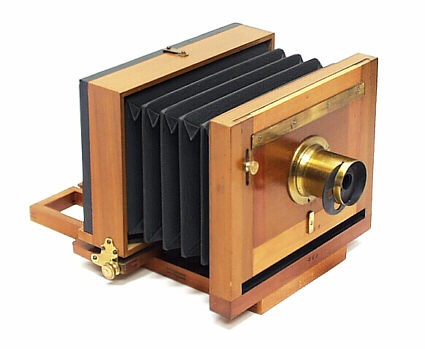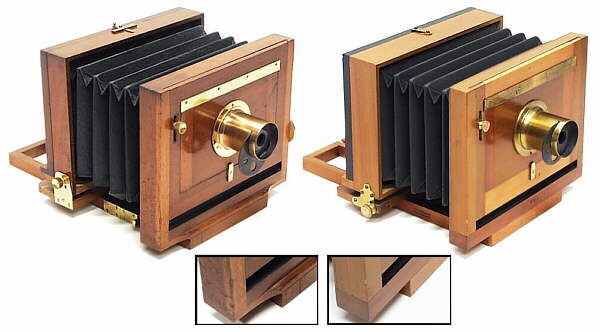|
|





Copyright ©2002 by Rob Niederman - ALL RIGHTS RESERVED
Visit the F. Putnam Reference page
Return to the View Cameras page
Return to the View Cameras page
Until recently, not much was known about the Marvel camera or the maker because of the
lack of advertising and catalog references. Then in the summer of 1999, I acquired what
appeared to be a Marvel catalogue issued by Franklin Putnam. For the first time, we
learned that "F" stood for "Franklin." But what looked like a catalogue was actually a
brochure that enticed "young men" to purchase Putnam's camera outfits and set up a
photography business.
Putnam's mid-1880s Descriptive Circular of Home Photography and Portable Photographic Outfits is likely the first sales brochure that described how to set up a photographic franchise. A camera outfit, complete with instructions, could be purchased from Putnam. Putnam continued to make money by selling darkroom chemicals, paper, and other necessities. This is the same concept governing franchise operations today.
Not even George Eastman practiced the "become a professional photographer in a week" gimmick to gain business. Putnam's unique approach to selling his outfits is probably unique in the history of 19th century photographic retailing.
The story of uncovering the legacy of Putnam and Marvel cameras started in 1998. Fellow collector Ben Ehrman and I were discussing items in our collections and discovered that we both had examples of the 5x8 Marvel by F. Putnam. We mused about finding these cameras curious, not because of the cameras themselves, but because of the mysterious "F. Putnam" moniker and the engaging name of "Marvel" stamped into the cameras. Actually, we think the exact words were, "Who the hell was Putnam?"
Putnam's mid-1880s Descriptive Circular of Home Photography and Portable Photographic Outfits is likely the first sales brochure that described how to set up a photographic franchise. A camera outfit, complete with instructions, could be purchased from Putnam. Putnam continued to make money by selling darkroom chemicals, paper, and other necessities. This is the same concept governing franchise operations today.
Not even George Eastman practiced the "become a professional photographer in a week" gimmick to gain business. Putnam's unique approach to selling his outfits is probably unique in the history of 19th century photographic retailing.
The story of uncovering the legacy of Putnam and Marvel cameras started in 1998. Fellow collector Ben Ehrman and I were discussing items in our collections and discovered that we both had examples of the 5x8 Marvel by F. Putnam. We mused about finding these cameras curious, not because of the cameras themselves, but because of the mysterious "F. Putnam" moniker and the engaging name of "Marvel" stamped into the cameras. Actually, we think the exact words were, "Who the hell was Putnam?"
Multi-Lens Cameras | View Cameras | Self-Casing Cameras | Solid Body Cameras | References & Advertisements
Home | What's New | Show Schedule | Wanted | For Sale | Links | Site Map | Email
Home | What's New | Show Schedule | Wanted | For Sale | Links | Site Map | Email
After acquiring the "Descriptive" brochure, and a year of diligent investigation, Ben and I managed to uncover a great deal of information that could
answer almost all questions about Putnam and his cameras. In September 2000, we published a monograph entitled Franklin Putnam and His
Photographic Apparatus in the Cascade Panaorama photographic journal (published by the Cascade Photo Historical Society).
Finally, we learned the truth about Putnam and his cameras. To our knowledge, no photograph of Franklin Putnam exists. We do not know the dates of his birth or death but two documents state that he was raised in a "pretty rough farm district" and "I worked eight whole months on a farm for only $100." The monograph is too lengthy to publish on this website, but I am pleased to present some of the most important highlights uncovered from the research.
Finally, we learned the truth about Putnam and his cameras. To our knowledge, no photograph of Franklin Putnam exists. We do not know the dates of his birth or death but two documents state that he was raised in a "pretty rough farm district" and "I worked eight whole months on a farm for only $100." The monograph is too lengthy to publish on this website, but I am pleased to present some of the most important highlights uncovered from the research.
5 x 8 Marvel Camera with Waterbury Lens
Light Wood And Brass Construction, s/n 471
Light Wood And Brass Construction, s/n 471
Marvel, 1880s
F. Putnam, NY
F. Putnam, NY
The most popular opinion held by collectors is that Marvel cameras were privately labeled Waterbury View cameras made by the Scovill Manufacturing
Company in the 1880s. As shown below, the Marvel camera (right) exhibits roughly the same dimensions and design as a Waterbury (left) and is almost
always found with a brass Waterbury landscape lens. In addition, manufacturing serial numbers on the body, focusing rails, rear standard, and
lensboard are placed in the same location as those found on a Waterbury View camera. If it looks like a duck, quacks like a duck, must be a duck ... or
in this case, a Waterbury.
However, our research concludes that the Marvel camera
is something other than a Waterbury. This is based on
differences found in the physical construction, wood finish,
and the brass hardware components. For example,
Waterbury cameras are built with matching mahogany
colored and grained wood parts while wood used to
construct Marvel cameras have a wide array of colors and
grain patterns. It is not unusual to find a Marvel camera
with a deep mahogany colored piece of wood glued to a
"greenish" looking wood part. The satin wood finish on a
Marvel appears to be varnish while the Waterbury's refined
glossy finish is likely a lacquer.
In addition, the Waterbury View camera's front standard has an aesthetically pleasing scalloped shape (left inset) where it attaches to the base. In comparison, the Marvel is perfectly flat (right inset).
Brass hardware components also exhibit differences. On the Waterbury camera, two brass hinges connect the ground glass frame to the body. Conversely, the Marvel camera does not use hinges, and as a result, the ground glass frame is completely removed from the body when attaching a plateholder.
In addition, the Waterbury View camera's front standard has an aesthetically pleasing scalloped shape (left inset) where it attaches to the base. In comparison, the Marvel is perfectly flat (right inset).
Brass hardware components also exhibit differences. On the Waterbury camera, two brass hinges connect the ground glass frame to the body. Conversely, the Marvel camera does not use hinges, and as a result, the ground glass frame is completely removed from the body when attaching a plateholder.
Comparison Of 5x8 inch Waterbury (left) and Marvel (Right) Tailboard View Cameras
When securing a ground glass frame or plateholder to the body, a simple flat piece of brass mounted on a screw serves as a primitive lock on the
Marvel. The Waterbury camera has a more elaborate design, which includes a tensioning spring to insure that the lock does not accidentally release.
Differences in hardware also extend to the folding bed. The Marvel has a single brass screw to lock the focusing rails in a flat position while the
Waterbury incorporates Mathias Flamming's patented sliding lock. [Note: Mathias Flammang originally patented this sliding lock design for use on his
cameras made by the American Optical Company.]
Closer examination of the Scovill catalogue of photograph apparatus uncovered a wood tailboard camera called the Favorite. Comparing advertisements and examples in collections, we discovered the Marvel and Favorite to be identifical in all regards. The primary difference was that Putnam stamped "Marvel" and "F.Putnam, New York" into the wood. Further proof was found in another collection that had a Marvel camera with a "Scovill" overstrike. This final piece of evidence proved that the Marvel camera was built in an American Optical or Scovill factory.
Closer examination of the Scovill catalogue of photograph apparatus uncovered a wood tailboard camera called the Favorite. Comparing advertisements and examples in collections, we discovered the Marvel and Favorite to be identifical in all regards. The primary difference was that Putnam stamped "Marvel" and "F.Putnam, New York" into the wood. Further proof was found in another collection that had a Marvel camera with a "Scovill" overstrike. This final piece of evidence proved that the Marvel camera was built in an American Optical or Scovill factory.
Interestingly, Putnam resold almost the entire Scovill photographic catalogue. And much to our surprise, Putnam privately labeled several more of
Scovill's cameras including two detective cameras (Scovill's Antique Oak Detective and Empire Hand Camera) and a 4-tube ferrotype camera that is
identical to Scovill's Ferrotype Bon Ton View Box.

